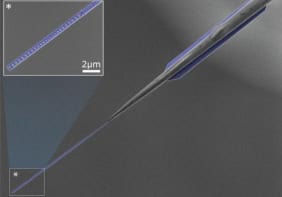
A new method for folding DNA into a range of useful shapes and for positioning these “origami” pieces onto industrial materials has been developed by researchers at IBM and the California Institute of Technology (Caltech). The resulting nanostructures could be used to create electronic and optical devices for cheaper, speedier and more powerful computer chips, say the researchers.
The origami method for manipulating DNA was developed originally in 2006 by Paul Rothemund at Caltech. It involves forcing a large viral genome to bend by the addition of small synthetic DNA sequences in a solution. The shorter segments attach to the main genome and act as “fastening posts” that hold the DNA in a range of shapes such as squares, triangles and stars that measure just 100–150 nm across.
Sticky shapes
One of the main limitations of the technique is that the DNA shapes need to be formed in a saltwater solution, which can damage surfaces such as silicon wafers. In addition, the DNA structures tend to arrange themselves randomly onto a substrate surface, which makes it difficult to integrate them into electronic circuits afterwards.
Now, Rothemund and colleagues have overcome this problem by developing a novel approach to DNA origami that could also enable researchers to position DNA shapes with improved accuracy. The researchers first “draw” an outline of the desired DNA origami shape onto a silica substrate using a combination of electron-beam lithography and oxidative etching. The negative-charge of these patches makes them “sticky”, so that when a solution of DNA and magnesium chloride is poured onto the surface, the positively charged magnesium ions draw DNA strands into these patches, causing them to fold.
To demonstrate the new technique, Rothemund and his team created a series of sticky triangles on a silica substrate and filled 95% of the sites, etching the sites to within 10° of a designated orientation. “Not only can we put origami where we want them, but they can be oriented in the direction we want them,” says Rothemund. He adds that he was “completely thrilled” with IBM’s contribution to the work. “I honestly thought it might take 10 years to solve the problem, if it was ever going to be solved at all.”
Nano-scaffolding
The resulting nanostructures might be used as scaffolds or as miniature circuit boards for precisely assembling components like carbon nanotubes and nanowires. Such circuits would be much smaller than those possible using conventional techniques to fabricate semiconductors. Indeed, the resolution of the process is roughly 10× higher than those currently used to make computer chips because the spacing between the components can be as small as just 6 nm, explains Rothemund.
An added bonus is that the process is not simply limited to organizing structures like electronic components but could come in handy for biological studies too. For example, it might be used to study how groups of proteins interact by placing the proteins in patterns on top of the DNA origami.
The Caltech-IBM team will now develop its technique by trying to position and orient asymmetric shapes as well as symmetric ones, like triangles. “Making multiple shapes that can all be used at once without interfering with each other so that we can construct more complex patterns on surfaces will also be important,” says Rothemund.
Eventually, the researchers will look at industrial applications – for example, using the origami to organize nanoelectronic components for use in computer chips.
This research was published in Nature Nanotechnology.



